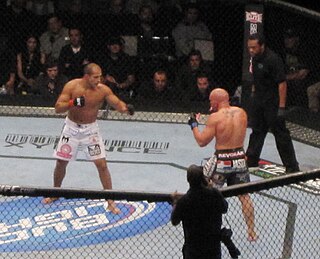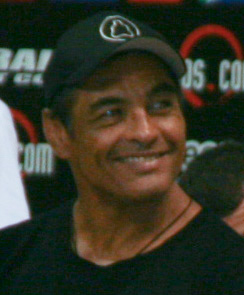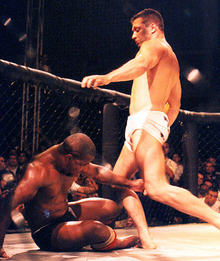
Mixed martial arts (MMA) is a full-contact combat sport based on striking, grappling and ground fighting, incorporating techniques from various combat sports from around the world. The first documented use of the term mixed martial arts was in a review of UFC 1 by television critic Howard Rosenberg in 1993.

PRIDE Fighting Championships was a Japanese mixed martial arts promotion company. Its inaugural event was held at the Tokyo Dome on October 11, 1997. Pride held more than sixty mixed martial arts events, broadcast to about 40 countries worldwide. PRIDE was owned by the holding company Dream Stage Entertainment (DSE).

Vale Tudo or vale-tudo, also known as No Holds Barred (NHB) in the United States, is an unarmed, full-contact combat sport with relatively few rules. It became popular in Brazil during the 20th century and would eventually evolve into modern Mixed martial arts (MMA). For years "Vale Tudo" was used as a synonym for MMA in Brazil, but the term fell into disuse due to the emergence of stricter rules and the influence of the media to have a more "civilized" name. It is now used to refer to an early, more rules-free stage of the modern sport.

Pancrase is a Japanese mixed martial arts (MMA) promotion company based in Tokyo. It was founded in 1993 by professional wrestlers Masakatsu Funaki and Minoru Suzuki.

Mark Daniel Coleman is an American retired mixed martial artist, professional wrestler and amateur wrestler. Coleman was the UFC 10 and UFC 11 tournament champion, the first UFC Heavyweight Champion, and the Pride Fighting Championships 2000 Open Weight Grand Prix champion. At UFC 82 Coleman was inducted into the UFC Hall of Fame.

Takanori Gomi is a Japanese professional mixed martial artist who gained international fame in Pride Fighting Championships. Later in his career, Gomi also competed in the Ultimate Fighting Championship. Gomi is the only Pride FC Lightweight Champion in the organization's history. He became the Lightweight Grand Prix Winner at Pride Shockwave 2005, thus winning every lightweight accolade put forth by Pride FC. Gomi also held a record twelve-fight winning streak in Shooto, where he was a former Shooto Lightweight Champion, as well as a four-time All-Japan Combat Wrestling Champion.

Rickson Gracie is a Brazilian retired mixed martial artist. He is a member of the Gracie family: the third oldest son of Hélio Gracie, brother to Rorion and Relson Gracie, and half-brother to Rolker, Royce, Robin and Royler Gracie. In the 1980s and 1990s, he was widely considered to be the best fighter of the Gracie clan, and one of the toughest in the world. In July 2017, he was promoted to ninth-degree red belt, the second-highest ranking in Brazilian jiu-jitsu.
Donald Frye is an American former mixed martial artist, professional wrestler, and actor. In MMA, he was one of the sport's earliest well-rounded fighters and won the UFC 8 and Ultimate Ultimate 96 tournaments and finished as runner-up UFC 10 in his first year of competition. He retired from MMA in 1997 to pursue a career in professional wrestling with New Japan Pro-Wrestling (NJPW) and quickly became one of the company's leading heels. After spending four years as one of Japan's top gaijin wrestlers, he returned to MMA with the Pride Fighting Championships in September 2001, much more muscular and sporting an American patriot persona in response to the September 11 attacks. He fought bouts with Ken Shamrock and Yoshihiro Takayama during his two years in Pride. He departed the promotion to compete in K-1 and Hero's in 2004 but returned for the final Pride event in 2007. He was inducted into the UFC Hall of Fame in 2016.

The Chute Boxe Academy is a Brazilian martial arts academy. It opened as a Muay Thai academy in 1978 in Curitiba, Paraná, Brazil. Head trainer Rudimar Fedrigo later expanded the program in 1991 to include other aspects of modern mixed martial arts, such as wrestling and submission grappling. By 1995, the Chute Boxe team was considered a prime training ground for Vale Tudo fighters. In 2004, an American branch, Chute Boxe USA, was established in Los Angeles, California.

Marco Antônio de Lima Ruas is a Brazilian former mixed martial arts fighter, submission wrestler, kickboxer and instructor. Ruas was the UFC 7 Tournament Champion, and also competed for the World Vale Tudo Championship (WVC), PRIDE Fighting Championships and the International Fight League, where he head-coached the Southern California Condors.
Ricardo Arona is a Brazilian former professional mixed martial artist, submission grappler and 4th degree Brazilian jiu-jitsu (BJJ) black belt practitioner.
Gary Henry Goodridge, nicknamed "Big Daddy", is a Trinidadian-Canadian former heavyweight kickboxer and mixed martial artist fighting out of Barrie, Ontario. Prior to kickboxing and MMA, he was also one of the top ranked contenders in the world of professional arm wrestling. In early 2012, Goodridge was diagnosed with early onset of chronic traumatic encephalopathy (CTE).
Daijiro Matsui is a Japanese mixed martial artist and professional wrestler. A professional MMA competitor since 1998, he has competed for the PRIDE Fighting Championships, Cage Rage, DEEP, Pancrase, and King of the Cage. As a professional wrestler, Matsui has wrestled for UWF International, Battlarts, New Japan Pro Wrestling, Inoki Genome Federation and most recently GLEAT.

Cage Rage Championships, also known as Cage Rage, was a United Kingdom-based, mixed martial arts promotion that premiered on 7 September 2002 in London. Cage Rage went into liquidation and is now no longer trading. Cage Rage had been owned and managed by Elite XC until that company ceased operating, and the British promoters behind Cage Rage formed a new organization and withdrew all the old Cage Rage titles. Matchmaker and on-screen personality Dave O'Donnell was also a minority shareholder in the company. Fellow on-screen personality and co-promoter Andy Geer also owned a minority stake until he left the promotion in 2008. Cage Rage events were replayed on Nuts TV, along with their own weekday show on The Fight Network until these channels closed down. Every Cage Rage event and bout is now archived as part of the UFC Fight Pass library.

Lyoto Carvalho Machida is a Brazilian professional mixed martial artist and karateka. He formerly competed for the Ultimate Fighting Championship (UFC), where he was a former UFC Light Heavyweight Champion, as well as a UFC Middleweight Championship title challenger. He most recently competed in Bellator MMA in the Light Heavyweight and Middleweight divisions.
Takashi Otsuka, better known by his ring name Alexander Otsuka and Otoko Sakari, is a retired Japanese mixed martial artist and professional wrestler. Having competed for multiple pro wrestling organizations in his career, most recently with Antonio Inoki's Inoki Genome Federation, he is known for his work in the promotion Battlarts.
Most rule sets for mixed martial arts (MMA) competitions have evolved since the early days of Vale Tudo. As a result of health, legal, and moral concerns, many different rulesets were created, which give different countries and promotions very different tactics and strategies. Similarly, shoot wrestling organizations, such as Shooto, expanded their rulesets to integrate elements of Vale Tudo into their sport. However, for the most part, fighters accustomed to one rule set can easily acclimate to the others.

World Victory Road (WVR) was a Japanese mixed martial arts (MMA) organization which promoted the Sengoku Raiden Championship (SRC) in Japan. The organization was formed in 2007 following the purchase of PRIDE FC by Zuffa. It operated in conjunction with the Japan Mixed Martial Arts Federation (JMM). The Sengoku championship was broadcast on Fuji TV and pay-per-view in Japan, and on HDNet in United States.
A 12–6 elbow, referred to in commentary as a "twelve to six elbow" and officially "downward elbow strikes", is a strike used in the combat sport of mixed martial arts (MMA). The name of the 12–6 elbow is based on the concept of a clock on the wall with the bringing of an elbow from straight up to straight down.

Mixed martial arts has been legal in Japan since at least the 1980s, Pancrase began to be held.













